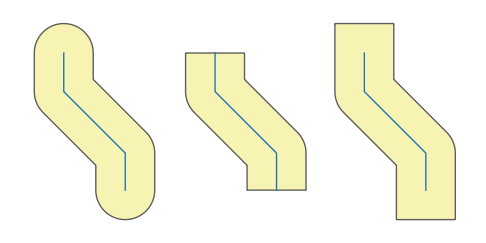29.1.8. Modeler ကိရိယာများ (Modeler tools)
Warning
Model designer ထဲတွင်သာ ယခု tool များကိုအသုံးပြုနိုင်ပါသည်။ Processing Toolbox ထဲတွင် ၎င်းတို့ကိုအသုံးပြု၍မရပါ။
29.1.8.1. အခြေအနေ အခွဲ (Conditional branch)
Model တစ်ခုထဲသို့ conditional branch (အခြေအနေအရ ကွဲထွက်မှု) တစ်ခုကိုပေါင်းထည့်ခြင်းဖြင့် expression အကဲဖြတ်ခြင်းတစ်ခု၏ရလာဒ်ပေါ်တွင် အခြေခံပြီး model ၏အစိတ်အပိုင်းများကို စေခိုင်းလုပ်ဆောင်နိုင်အောင် ဖန်တီးပေးပါသည်။ Model တစ်ခု၏လုပ်ငန်းဆောင်တာများကို ထိန်းချုပ်ရန် tool dependency (အမှီအခို) များကို များသောအားဖြင့် အသုံးပြုပါသည်။
သတ်မှတ်ချက်များ (Parameters)
အညွှန်း |
အမည် |
အမျိုးအစား |
ရှင်းလင်းဖော်ပြချက် |
|---|---|---|---|
Field |
|
[string] |
အခြေအနေ၏ အမည် |
Field |
|
[expression] |
အကဲဖြတ်ရန် expression |
ရလာဒ်များ (Outputs)
ဘာမှမရှိပါ။
Python code
Algorithm ID: native:condition
import processing
processing.run("algorithm_id", {parameter_dictionary})
Processing Toolbox ထဲရှိ algorithm ပေါ်တွင် mouse ကိုတင်ထားလျှင် algorithm id ကိုပြသပေးပါသည်။ parameter dictionary သည် parameter နာမည်များနှင့် တန်ဖိုးများကို ပေးပါသည်။ Python console မှ algorithm များကို မည်သို့လုပ်ဆောင်ရမည် ဆိုသည့် အသေးစိတ်ကို သိရှိလိုလျှင် Console တွင် processing algorithm များကို အသုံးပြုခြင်း တွင်ကြည့်ပါ။
29.1.8.2. ဖိုင်လမ်းကြောင်းကိုဖန်တီးခြင်း (Create directory)
File system တစ်ခုထဲတွင် လမ်းကြောင်းအသစ်တစ်ခုဖန်တီးပေးပါသည်။ လမ်းကြောင်းများကို အဆင့်ဆင့်ဖန်တီးမည်ဖြစ်ပြီး အတိအကျလမ်းကြောင်းအပြည့်ကို တည်ဆောက်ရန်အတွက် လိုအပ်သော parent (ပင်မ) လမ်းကြောင်းများအားလုံးကို ဖန်တီးမည်ဖြစ်သည်။ လမ်းကြောင်းရှိနေပြီးသား ဖြစ်နေလျှင် အမှားနှင့်ပြဿနာ ရှိမည်မဟုတ်ပါ။
သတ်မှတ်ချက်များ (Parameters)
အညွှန်း |
အမည် |
အမျိုးအစား |
ရှင်းလင်းဖော်ပြချက် |
|---|---|---|---|
Directory path (လမ်းကြောင်း) |
|
[string] |
ဖန်တီးမည့် folder လမ်းကြောင်း |
ရလာဒ်များ (Outputs)
အညွှန်း |
အမည် |
အမျိုးအစား |
ရှင်းလင်းဖော်ပြချက် |
|---|---|---|---|
Output |
|
[folder] |
ဖန်တီးထားသော folder |
Python code
Algorithm ID: native:createdirectory
import processing
processing.run("algorithm_id", {parameter_dictionary})
Processing Toolbox ထဲရှိ algorithm ပေါ်တွင် mouse ကိုတင်ထားလျှင် algorithm id ကိုပြသပေးပါသည်။ parameter dictionary သည် parameter နာမည်များနှင့် တန်ဖိုးများကို ပေးပါသည်။ Python console မှ algorithm များကို မည်သို့လုပ်ဆောင်ရမည် ဆိုသည့် အသေးစိတ်ကို သိရှိလိုလျှင် Console တွင် processing algorithm များကို အသုံးပြုခြင်း တွင်ကြည့်ပါ။
29.1.8.3. Feature များကိုစစ်ထုတ်ရာ (Feature filter)
Input layer မှ feature များကိုရွေးချယ်စစ်ထုတ်ပြီး ၎င်းတို့ကို တစ်ခု သို့မဟုတ် များစွာသော output များဆီသို့ပြန်လည်လမ်းညွှန်ပေးပါသည်။ ဖြစ်နိုင်သော input layer အားလုံး၏ အသုံးများသော အချက်အလက်နာမည်များကို မသိလျှင် $id နှင့် uuid ကဲ့သို့သော feature geometry နှင့် အထွေထွေ မှတ်တမ်းအစိတ်အပိုင်းများထဲတွင်သာ ရွေးချယ်စစ်ထုတ်နိုင်ပါသည်။
သတ်မှတ်ချက်များ (Parameters)
အညွှန်း |
အမည် |
အမျိုးအစား |
ရှင်းလင်းဖော်ပြချက် |
|---|---|---|---|
Input layer (ထည့်သွင်းအသုံးပြုသော layer) |
|
[vector: any] |
ထည့်သွင်းအသုံးပြုသော layer |
Outputs and filters (Output များနှင့် ရွေးချယ်စစ်ထုတ်မှုများ) (တစ်ခု သို့မဟုတ် တစ်ခုထက်ပိုသော) |
|
[input နှင့်အတူတူဖြစ်ပါသည်] |
ရွေးချယ်စစ်ထုတ်မှုများ (ရွေးချယ်စစ်ထုတ်မှုများနိုင်သမျှ များများ) ဖြင့် output layer များ |
ရလာဒ်များ (Outputs)
အညွှန်း |
အမည် |
အမျိုးအစား |
ရှင်းလင်းဖော်ပြချက် |
|---|---|---|---|
Output (ရလာဒ်) (တစ်ခု သို့မဟုတ် တစ်ခုထက်ပိုသော) |
|
[input နှင့်အတူတူဖြစ်ပါသည်] |
ရွေးချယ်စစ်ထုတ်မှုများ (ရွေးချယ်စစ်ထုတ်မှုများနိုင်သမျှ များများ) ဖြင့် output layer များ |
Python code
Algorithm ID: native:filter
import processing
processing.run("algorithm_id", {parameter_dictionary})
Processing Toolbox ထဲရှိ algorithm ပေါ်တွင် mouse ကိုတင်ထားလျှင် algorithm id ကိုပြသပေးပါသည်။ parameter dictionary သည် parameter နာမည်များနှင့် တန်ဖိုးများကို ပေးပါသည်။ Python console မှ algorithm များကို မည်သို့လုပ်ဆောင်ရမည် ဆိုသည့် အသေးစိတ်ကို သိရှိလိုလျှင် Console တွင် processing algorithm များကို အသုံးပြုခြင်း တွင်ကြည့်ပါ။
29.1.8.4. Layers အမျိုးအစားဖြင့် စစ်ထုတ်ခြင်း (Filter layers by type)
Layer များကို ၎င်းတို့၏အမျိုးအစားဖြင့် ရွေးချယ်စစ်ထုတ်ပေးပါသည်။ ဝင်လာသော layer များကို vector ဖြစ်သည် သို့မဟုတ် raster ဖြစ်သည် အပေါ်မူတည်ပြီး output အမျိုးမျိုးသို့ လမ်းညွှန်ပေးပါလိမ့်မည်။
သတ်မှတ်ချက်များ (Parameters)
အညွှန်း |
အမည် |
အမျိုးအစား |
ရှင်းလင်းဖော်ပြချက် |
|---|---|---|---|
Input layer (ထည့်သွင်းအသုံးပြုသော layer) |
|
[layer] |
ယေဘုယျ မြေပုံ layer |
ရလာဒ်များ (Outputs)
အညွှန်း |
အမည် |
အမျိုးအစား |
ရှင်းလင်းဖော်ပြချက် |
|---|---|---|---|
Vector features (Vector feature များ) Optional (မဖြစ်မနေလုပ်ဆောင်ရန် မလိုအပ်ပါ) |
|
[vector] |
ကိုက်ညီမှုရှိလျှင် input ၏ vector layer တစ်ခု |
Raster layer Optional (မဖြစ်မနေလုပ်ဆောင်ရန် မလိုအပ်ပါ) |
|
[raster] |
ကိုက်ညီမှုရှိလျှင် input ၏ raser layer တစ်ခု |
Python code
Algorithm ID: native:filterlayersbytype
import processing
processing.run("algorithm_id", {parameter_dictionary})
Processing Toolbox ထဲရှိ algorithm ပေါ်တွင် mouse ကိုတင်ထားလျှင် algorithm id ကိုပြသပေးပါသည်။ parameter dictionary သည် parameter နာမည်များနှင့် တန်ဖိုးများကို ပေးပါသည်။ Python console မှ algorithm များကို မည်သို့လုပ်ဆောင်ရမည် ဆိုသည့် အသေးစိတ်ကို သိရှိလိုလျှင် Console တွင် processing algorithm များကို အသုံးပြုခြင်း တွင်ကြည့်ပါ။
29.1.8.5. Layer ကို project ထဲသို့ထည့်သွင်းခြင်း (Load layer into project)
လက်ရှိ project ထဲသို့ layer တစ်ခုခေါ်ယူထည့်သွင်းပေးပါသည်။
သတ်မှတ်ချက်များ (Parameters)
အညွှန်း |
အမည် |
အမျိုးအစား |
ရှင်းလင်းဖော်ပြချက် |
|---|---|---|---|
Layer |
|
[layer] |
ရည်ညွှန်းချက်ထဲတွင် ထည့်သွင်းမည့် layer |
Loaded layer name (ထည့်သွင်းထားသော layer အမည်) |
|
[string] |
ထည့်သွင်းထားသော layer ၏အမည် |
ရလာဒ်များ (Outputs)
အညွှန်း |
အမည် |
အမျိုးအစား |
ရှင်းလင်းဖော်ပြချက် |
|---|---|---|---|
Layer |
|
[input နှင့်အတူတူဖြစ်ပါသည်] |
ထည့်သွင်းထားသော layer (နာမည်ပြန်ပေးထားသော) |
Python code
Algorithm ID: native:loadlayer
import processing
processing.run("algorithm_id", {parameter_dictionary})
Processing Toolbox ထဲရှိ algorithm ပေါ်တွင် mouse ကိုတင်ထားလျှင် algorithm id ကိုပြသပေးပါသည်။ parameter dictionary သည် parameter နာမည်များနှင့် တန်ဖိုးများကို ပေးပါသည်။ Python console မှ algorithm များကို မည်သို့လုပ်ဆောင်ရမည် ဆိုသည့် အသေးစိတ်ကို သိရှိလိုလျှင် Console တွင် processing algorithm များကို အသုံးပြုခြင်း တွင်ကြည့်ပါ။
29.1.8.6. ချွင်းချက်ထုတ်ခြင်း (Raise exception)
ချွင်းချက် (exception) တစ်ခုလုပ်ဆောင်ပြီး model ကိုစေခိုင်းလုပ်ဆောင်ခြင်းမှ ရပ်တန့်ပေးပါသည်။ ချွင်းချက်အတွက်ဖော်ပြမှုစာသားကို စိတ်ကြိုက်ပြင်ဆင်နိုင်ပြီး expression ကိုအခြေခံသော အခြေအနေတစ်ခုကို သတ်မှတ်နိုင်ပါသည်။ Expression အခြေအနေတစ်ခုကို အသုံးပြုထားလျှင် expression ရလာဒ်သည် မှန်မှသာ ချွင်းချက်ကို လုပ်ဆောင်ပေးမည် ဖြစ်ပါသည်။ Expression ရလာဒ်အမှားသည် ချွင်းချက်ကို လုပ်ဆောင်မည်မဟုတ်ပဲ model စေခိုင်းလုပ်ဆောင်ခြင်းကို အနှောင့်အယှက်မရှိပဲ ဆက်လက်လုပ်ဆောင်နိုင်ပါသည်။
သတ်မှတ်ချက်များ (Parameters)
အညွှန်း |
အမည် |
အမျိုးအစား |
ရှင်းလင်းဖော်ပြချက် |
|---|---|---|---|
Message (စာတို) |
|
[string] |
ဖော်ပြမည့်စာတို |
Condition (အခြေအနေ) Optional (မဖြစ်မနေလုပ်ဆောင်ရန် မလိုအပ်ပါ) |
|
[expression] |
အမှန်ဖြစ်လျှင် အကဲဖြတ်မည့် expression |
ရလာဒ်များ (Outputs)
Log (မှတ်တမ်း) panel ထဲတွင် ဖော်ပြသည့် စာသား။
Python code
Algorithm ID: native:raiseexception
import processing
processing.run("algorithm_id", {parameter_dictionary})
Processing Toolbox ထဲရှိ algorithm ပေါ်တွင် mouse ကိုတင်ထားလျှင် algorithm id ကိုပြသပေးပါသည်။ parameter dictionary သည် parameter နာမည်များနှင့် တန်ဖိုးများကို ပေးပါသည်။ Python console မှ algorithm များကို မည်သို့လုပ်ဆောင်ရမည် ဆိုသည့် အသေးစိတ်ကို သိရှိလိုလျှင် Console တွင် processing algorithm များကို အသုံးပြုခြင်း တွင်ကြည့်ပါ။
29.1.8.7. စာတိုဖော်ပြခြင်း (Raise message)
Log ထဲတွင် သတင်းအချက်အလက်စာတိုတစ်ခုကိုဖော်ပြပေးပါသည်။ ဖော်ပြမည့်စာတိုကို စိတ်ကြိုက်ပြင်ဆင်နိုင်ပြီး expression ကိုအခြေခံသော အခြေအနေတစ်ခုကို သတ်မှတ်နိုင်ပါသည်။ Expression အခြေအနေတစ်ခုကို အသုံးပြုထားလျှင် expression ရလာဒ်သည် မှန်မှသာ စာတိုကို ဖော်ပြပေးမည် ဖြစ်ပါသည်။ Expression ရလာဒ်အမှားသည် စာတိုကိုဖော်ပြမည်မဟုတ်ပါ။
သတ်မှတ်ချက်များ (Parameters)
အညွှန်း |
အမည် |
အမျိုးအစား |
ရှင်းလင်းဖော်ပြချက် |
|---|---|---|---|
Information message (သတင်းအချက်အလက် စာတို) |
|
[string] |
ဖော်ပြမည့်စာတို |
Condition (အခြေအနေ) Optional (မဖြစ်မနေလုပ်ဆောင်ရန် မလိုအပ်ပါ) |
|
[expression] |
အမှန်ဖြစ်လျှင် အကဲဖြတ်မည့် expression |
ရလာဒ်များ (Outputs)
Log panel ထဲရှိ စာတိုတစ်ခု။
Python code
Algorithm ID: native:raisemessage
import processing
processing.run("algorithm_id", {parameter_dictionary})
Processing Toolbox ထဲရှိ algorithm ပေါ်တွင် mouse ကိုတင်ထားလျှင် algorithm id ကိုပြသပေးပါသည်။ parameter dictionary သည် parameter နာမည်များနှင့် တန်ဖိုးများကို ပေးပါသည်။ Python console မှ algorithm များကို မည်သို့လုပ်ဆောင်ရမည် ဆိုသည့် အသေးစိတ်ကို သိရှိလိုလျှင် Console တွင် processing algorithm များကို အသုံးပြုခြင်း တွင်ကြည့်ပါ။
29.1.8.8. သတိပေးချက် ဖော်ပြခြင်း (Raise warning)
Log ထဲတွင် သတိပေးစာသားတစ်ခုကို ဖော်ပြပေးပါသည်။ ဖော်ပြမည့်သတိပေးစာသားကို စိတ်ကြိုက်ပြင်ဆင်နိုင်ပြီး expression ကိုအခြေခံသော အခြေအနေတစ်ခုကို သတ်မှတ်နိုင်ပါသည်။ Expression အခြေအနေတစ်ခုကို အသုံးပြုထားလျှင် expression ရလာဒ်သည် မှန်မှသာ သတိပေးချက်ကို ဖော်ပြပေးမည် ဖြစ်ပါသည်။ Expression ရလာဒ်အမှားသည် သတိပေးချက်ကိုဖော်ပြမည်မဟုတ်ပါ။
သတ်မှတ်ချက်များ (Parameters)
အညွှန်း |
အမည် |
အမျိုးအစား |
ရှင်းလင်းဖော်ပြချက် |
|---|---|---|---|
Message (စာတို) |
|
[string] |
ဖော်ပြမည့်စာတို |
Condition (အခြေအနေ) Optional (မဖြစ်မနေလုပ်ဆောင်ရန် မလိုအပ်ပါ) |
|
[expression] |
အမှန်ဖြစ်လျှင် အကဲဖြတ်မည့် expression |
ရလာဒ်များ (Outputs)
Log panel ထဲတွင် ဖော်ပြသည့် စာတိုတစ်ခု။
Python code
Algorithm ID: native:raisewarning
import processing
processing.run("algorithm_id", {parameter_dictionary})
Processing Toolbox ထဲရှိ algorithm ပေါ်တွင် mouse ကိုတင်ထားလျှင် algorithm id ကိုပြသပေးပါသည်။ parameter dictionary သည် parameter နာမည်များနှင့် တန်ဖိုးများကို ပေးပါသည်။ Python console မှ algorithm များကို မည်သို့လုပ်ဆောင်ရမည် ဆိုသည့် အသေးစိတ်ကို သိရှိလိုလျှင် Console တွင် processing algorithm များကို အသုံးပြုခြင်း တွင်ကြည့်ပါ။
29.1.8.9. Layer အမည်ပြောင်းခြင်း (Rename layer)
Layer တစ်ခုကို နာမည်ပြန်ပေးပါသည်။
သတ်မှတ်ချက်များ (Parameters)
အညွှန်း |
အမည် |
အမျိုးအစား |
ရှင်းလင်းဖော်ပြချက် |
|---|---|---|---|
Layer |
|
[layer] |
အမည်ပြန်ပေးမည့် layer |
New name (အမည်အသစ်) |
|
[string] |
Layer ၏အမည်အသစ် |
ရလာဒ်များ (Outputs)
အညွှန်း |
အမည် |
အမျိုးအစား |
ရှင်းလင်းဖော်ပြချက် |
|---|---|---|---|
Layer |
|
[input နှင့်အတူတူဖြစ်ပါသည်] |
Output layer (အမည်ပြန်ပေးထားသော) |
Python code
Algorithm ID: native:renamelayer
import processing
processing.run("algorithm_id", {parameter_dictionary})
Processing Toolbox ထဲရှိ algorithm ပေါ်တွင် mouse ကိုတင်ထားလျှင် algorithm id ကိုပြသပေးပါသည်။ parameter dictionary သည် parameter နာမည်များနှင့် တန်ဖိုးများကို ပေးပါသည်။ Python console မှ algorithm များကို မည်သို့လုပ်ဆောင်ရမည် ဆိုသည့် အသေးစိတ်ကို သိရှိလိုလျှင် Console တွင် processing algorithm များကို အသုံးပြုခြင်း တွင်ကြည့်ပါ။
29.1.8.10. Log ကို file အဖြစ် သိမ်းဆည်းခြင်း (Save log to file)
Model ကိုစေခိုင်းလုပ်ဆောင်ခြင်း log ကို file တစ်ခုအဖြစ်သိမ်းဆည်းပေးပါသည်။ HTML format ဖြင့်ပြင်ဆင်ထားသော version အဖြစ်လည်း log ကိုသိမ်းဆည်းနိုင်ပါသည်။
သတ်မှတ်ချက်များ (Parameters)
အညွှန်း |
အမည် |
အမျိုးအစား |
ရှင်းလင်းဖော်ပြချက် |
|---|---|---|---|
Use HTML (HTML ကိုအသုံးပြုခြင်း) |
|
[Boolean] Default: False |
HTML format ကိုအသုံးပြုပါ |
ရလာဒ်များ (Outputs)
အညွှန်း |
အမည် |
အမျိုးအစား |
ရှင်းလင်းဖော်ပြချက် |
|---|---|---|---|
File |
|
[string] |
Log ၏တည်နေရာ |
Python code
Algorithm ID: native:savelog
import processing
processing.run("algorithm_id", {parameter_dictionary})
Processing Toolbox ထဲရှိ algorithm ပေါ်တွင် mouse ကိုတင်ထားလျှင် algorithm id ကိုပြသပေးပါသည်။ parameter dictionary သည် parameter နာမည်များနှင့် တန်ဖိုးများကို ပေးပါသည်။ Python console မှ algorithm များကို မည်သို့လုပ်ဆောင်ရမည် ဆိုသည့် အသေးစိတ်ကို သိရှိလိုလျှင် Console တွင် processing algorithm များကို အသုံးပြုခြင်း တွင်ကြည့်ပါ။
29.1.8.11. Project ကိန်းရှင်ကို သတ်မှတ်ခြင်း (Set project variable)
လက်ရှိ project အတွက် expression variable (ကိန်းရှင်) တစ်ခုကို သတ်မှတ်ပေးပါသည်။
သတ်မှတ်ချက်များ (Parameters)
အညွှန်း |
အမည် |
အမျိုးအစား |
ရှင်းလင်းဖော်ပြချက် |
|---|---|---|---|
Variable name (Variable အမည်) |
|
[string] |
Variable ၏အမည် |
Variable value (Variable တန်ဖိုး) |
|
[string] |
သိမ်းဆည်းမည့် တန်ဖိုး |
ရလာဒ်များ (Outputs)
ဘာမှမရှိပါ။
Python code
Algorithm ID: native:setprojectvariable
import processing
processing.run("algorithm_id", {parameter_dictionary})
Processing Toolbox ထဲရှိ algorithm ပေါ်တွင် mouse ကိုတင်ထားလျှင် algorithm id ကိုပြသပေးပါသည်။ parameter dictionary သည် parameter နာမည်များနှင့် တန်ဖိုးများကို ပေးပါသည်။ Python console မှ algorithm များကို မည်သို့လုပ်ဆောင်ရမည် ဆိုသည့် အသေးစိတ်ကို သိရှိလိုလျှင် Console တွင် processing algorithm များကို အသုံးပြုခြင်း တွင်ကြည့်ပါ။
29.1.8.12. စာသားများချိတ်ဆက်ပေါင်းစပ်ခြင်း (String concatenation)
Processing Modeler ထဲတွင် စာသားနှစ်ခုကို တစ်ခုတည်းအဖြစ် ချိတ်ဆက်ပေါင်းစပ်ပေးပါသည်။
သတ်မှတ်ချက်များ (Parameters)
အညွှန်း |
အမည် |
အမျိုးအစား |
ရှင်းလင်းဖော်ပြချက် |
|---|---|---|---|
Input 1 |
|
[string] |
ပထမစာသား |
Input 2 |
|
[string] |
ဒုတိယစာသား |
ရလာဒ်များ (Outputs)
အညွှန်း |
အမည် |
အမျိုးအစား |
ရှင်းလင်းဖော်ပြချက် |
|---|---|---|---|
Concatenation (ချိတ်ဆက်ပေါင်းစပ်ပေးခြင်း) |
|
[string] |
ချိတ်ဆက်ပေါင်းစပ်ထားသော စာသား |
Python code
Algorithm ID: native:stringconcatenation
import processing
processing.run("algorithm_id", {parameter_dictionary})
Processing Toolbox ထဲရှိ algorithm ပေါ်တွင် mouse ကိုတင်ထားလျှင် algorithm id ကိုပြသပေးပါသည်။ parameter dictionary သည် parameter နာမည်များနှင့် တန်ဖိုးများကို ပေးပါသည်။ Python console မှ algorithm များကို မည်သို့လုပ်ဆောင်ရမည် ဆိုသည့် အသေးစိတ်ကို သိရှိလိုလျှင် Console တွင် processing algorithm များကို အသုံးပြုခြင်း တွင်ကြည့်ပါ။
29.1.8.13. အကျယ်မတူသည့် ကြားခံနယ်များ ပြုလုပ်ခြင်း (Variable distance buffer)
Warning
ယခု algorithm ကို တိုးတက်မှုတစ်စုံတရာထပ်မံလုပ်ဆောင်ခြင်းမရှိတော့၍ အချိန်မရွေးဖယ်ထုတ်ပစ်ခံရနိုင်ပါသည်။ ၎င်းအစား ကြားခံဇုံ (Buffer) algorithm ကိုဦးစားပေး အသုံးပြုပါ။
Input layer တစ်ခုထဲရှိ feature များအားလုံးအတွက် buffer ဧရိယာတစ်ခုကိုတွက်ချက်ပေးပါသည်။
အသုံးပြုထားသော feature အတွက် buffer အရွယ်အစားကို attribute တစ်ခုဖြင့် သတ်မှတ်ပြီး feature အမျိုးမျိုးကို buffer အရွယ်အစား အမျိုးမျိုး ရရှိအောင်လုပ်ဆောင်ပေးပါသည်။
See also
သတ်မှတ်ချက်များ (Parameters)
အညွှန်း |
အမည် |
အမျိုးအစား |
ရှင်းလင်းဖော်ပြချက် |
|---|---|---|---|
Input layer (ထည့်သွင်းအသုံးပြုသော layer) |
|
[vector: any] |
ထည့်သွင်းအသုံးပြုသော vector layer |
Distance field (အကွာအဝေး field) |
|
[tablefield: numeric] |
Buffer ၏ အချင်းဝက်အကွာအဝေးအတွက် attribute |
Segments (မျဉ်းပိုင်းများ) |
|
[number] Default: 5 |
လုံးဝန်းသော offset (အရွေ့) များကိုဖန်တီးသောအခါ စက်ဝိုင်းလေးပုံတစ်ပုံကို ခန့်မှန်းရန်အတွက်အသုံးပြုမည့် မျဉ်းပိုင်းများ၏ အရေအတွက်ကို ထိန်းချုပ်ပေးပါသည်။ |
Dissolve result (ပေါင်းထားသောရလာဒ်) |
|
[boolean] Default: False |
နောက်ဆုံး buffer ကို dissolve ပြုလုပ်ရန် ရွေးချယ်ခြင်းသည် input feature များအားလုံးကိုလွှမ်းခြုံသော feature တစ်ခုတည်းကို ရရှိစေပါသည်။ 
Fig. 29.8 ပုံမှန် buffer နှင့် dissolve လုပ်ထားသော buffer |
End cap style (အဆုံးသတ်အပိတ် style) |
|
[enumeration] Default: Round (လုံးဝန်းသော) |
Buffer ထဲတွင် line အဆုံးသတ်များကို မည်သို့လုပ်ဆောင်သည်ကို ထိန်းချုပ်ပေးပါသည်။ 
Fig. 29.9 လုံးဝန်းသောအဝိုက်၊ အပြားနှင့် စတုရန်းပုံ အပိတ် style များ |
Join style (ချိတ်ဆက်သော style) |
|
[enumeration] Default: Round (လုံးဝန်းသောအဝိုက်) |
Line တစ်ခု၏ ထောင့်စွန်းများကို offset လုပ်သောအခါ round (စောင်းလုံး) ၊ miter (စောင်းတိ) သို့မဟုတ် bevel (စောင်းသတ်) ချိတ်ဆက်ခြင်းများကို အသုံးပြုသင့်သလား ဆိုသည်ကို သတ်မှတ်ပေးပါသည်။ |
Miter limit (Miter ကန့်သတ်ချက်) |
|
[number] Default: 2.0 |
Miter ဖြင့်ချိတ်ဆက်သော style များအတွက်သာအသုံးပြုနိုင်ပြီး miter ဖြင့်ချိတ်ဆက်မှုတစ်ခုကို ဖန်တီးသောအခါ အသုံးပြုသည့် offset curve မှ အများဆုံးအကွာအဝေးကို ထိန်းချုပ်ပေးပါသည်။ |
ရလာဒ်များ (Outputs)
အညွှန်း |
အမည် |
အမျိုးအစား |
ရှင်းလင်းဖော်ပြချက် |
|---|---|---|---|
Buffer |
|
[vector: polygon] |
Buffer ပြုလုပ်ထားသော polygon vector layer |
Python code
Algorithm ID: qgis:variabledistancebuffer
import processing
processing.run("algorithm_id", {parameter_dictionary})
Processing Toolbox ထဲရှိ algorithm ပေါ်တွင် mouse ကိုတင်ထားလျှင် algorithm id ကိုပြသပေးပါသည်။ parameter dictionary သည် parameter နာမည်များနှင့် တန်ဖိုးများကို ပေးပါသည်။ Python console မှ algorithm များကို မည်သို့လုပ်ဆောင်ရမည် ဆိုသည့် အသေးစိတ်ကို သိရှိလိုလျှင် Console တွင် processing algorithm များကို အသုံးပြုခြင်း တွင်ကြည့်ပါ။